SITE PATH
ONE ENERGY FEED

SUBSCRIBE
CONNECT WITH US
News Filters

The sign pictured below sits right outside One Energy’s headquarters and welcomes all our guests to the office.
In a previous Wind View, we showed you the North Findlay Wind Campus and discussed how we incorporated some turbine elements into our office. Well, it doesn’t stop with the building – we are surrounded by our work!
For example, this custom-made sign was constructed with a Wind for Industry project component! The big blue circular structure surrounding our logo is called an embedment ring, and it’s used in the foundation of our wind turbines.
This sign is just another opportunity for us to tell our story with our work!
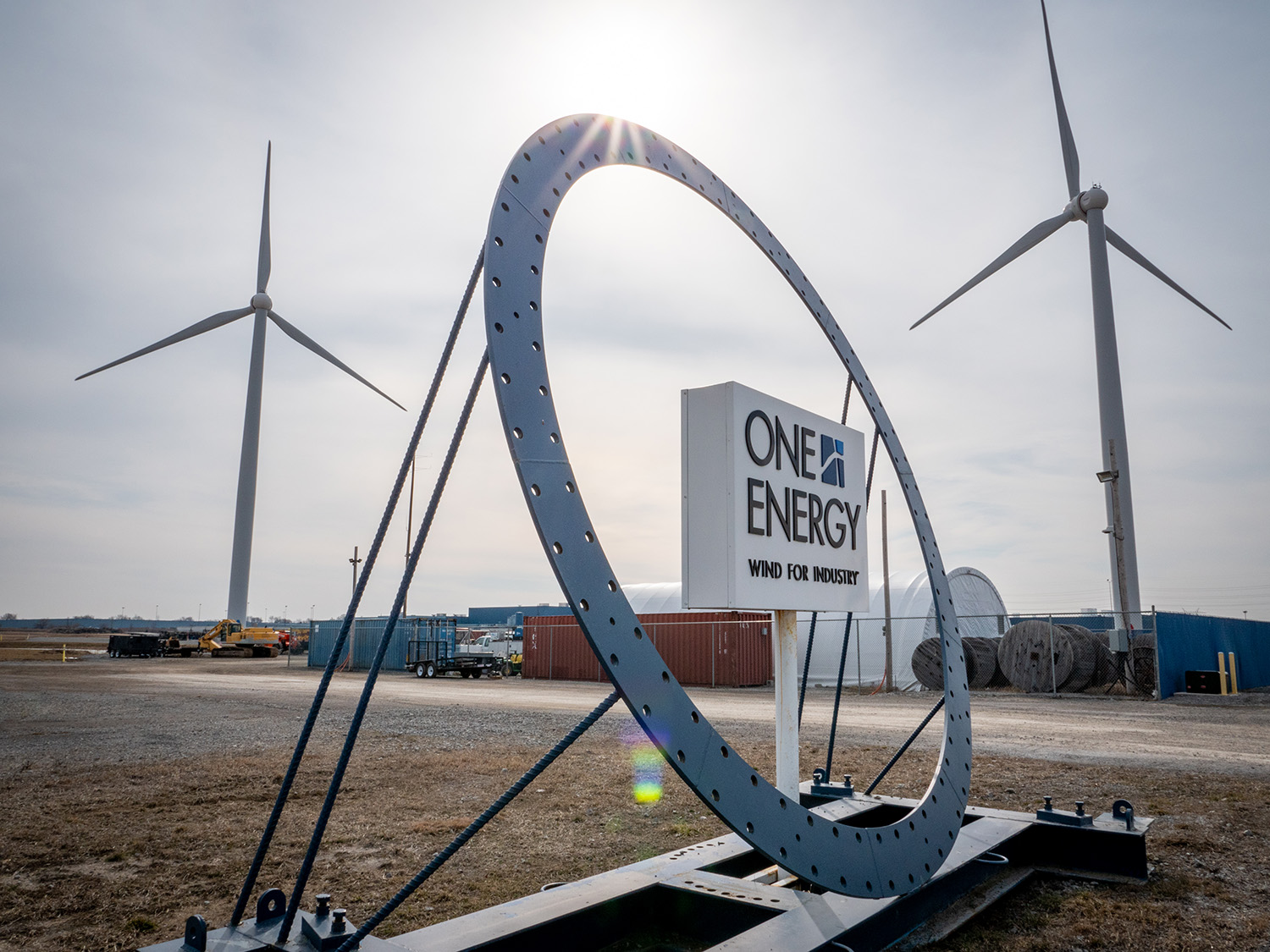

Ever notice the metal cylinder on the utility pole near your house? That’s called a transformer!
Transformers are used to lower the voltage of the power that comes from the electric grid (in this case, so that the electricity can be used in your house).
At One Energy, we also use transformers, but the industrial plants that One Energy helps power require a much higher voltage than a house. To supply this high voltage to our consumers, we must increase the voltage using a step-up transformer.
These rectangular transformers are much bigger than the ones found on the utility poles near your house (as you can see in the picture below), and we use them to step up the voltage of the wind turbine to the grid voltage.
Transformers use two coils of wire and the principle of electromagnetic induction to change the voltage. The coils are wrapped around the same core, but each coil has a different number of loops (called turns) that create the change in voltage.
Today’s Wind Study homework questions use the Turns Ratio to determine the correlation between the number of turns in each of the coils and the change in voltage the transformer produces.
Download the questions to learn more! And be sure to share this educational series on Facebook and Twitter!
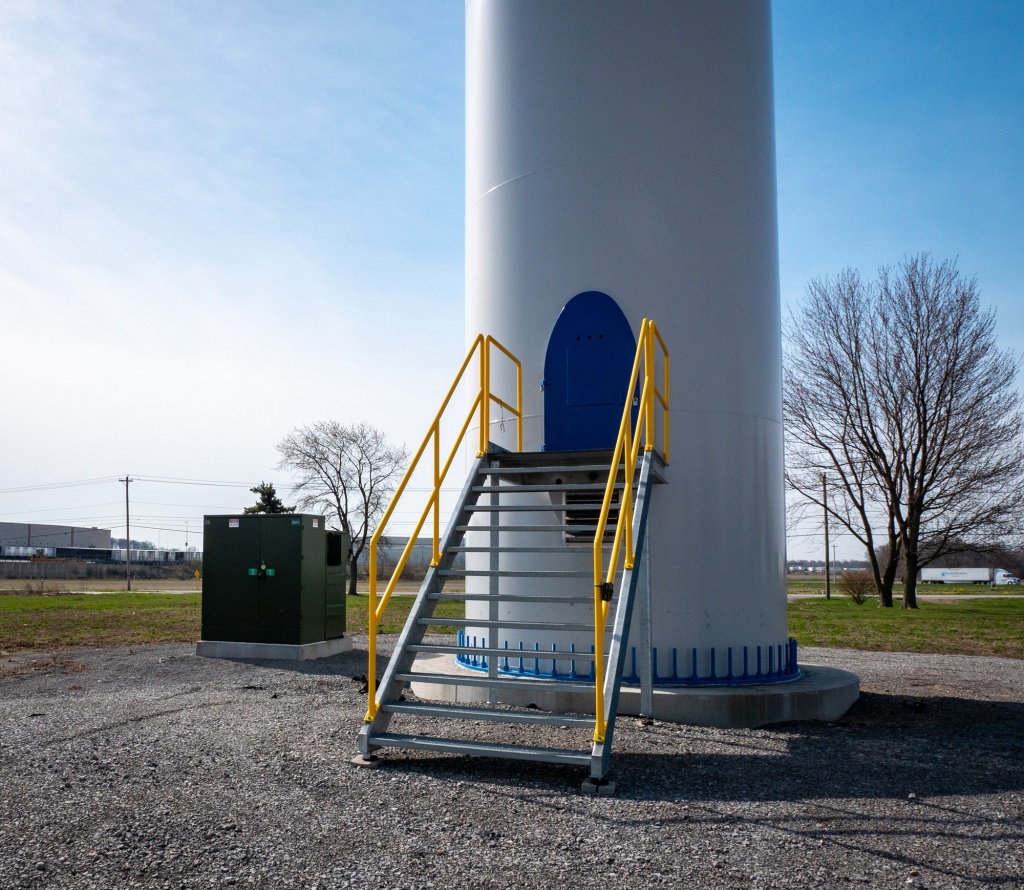

This week, we asked you to help us with wind turbine siting by determining the relationship between wind speed and hub height, and by solving a “Wind Profile Power Law” calculation.
Your homework was to complete some graphing and equations – the same ones we use at One Energy when deciding where to install wind turbines!
🔗 Find out if you got it right by reviewing the answers, linked here.
And get ready for next week’s Wind Study problem, publishing this coming Monday!
Remember to share this educational series on Facebook and Twitter!
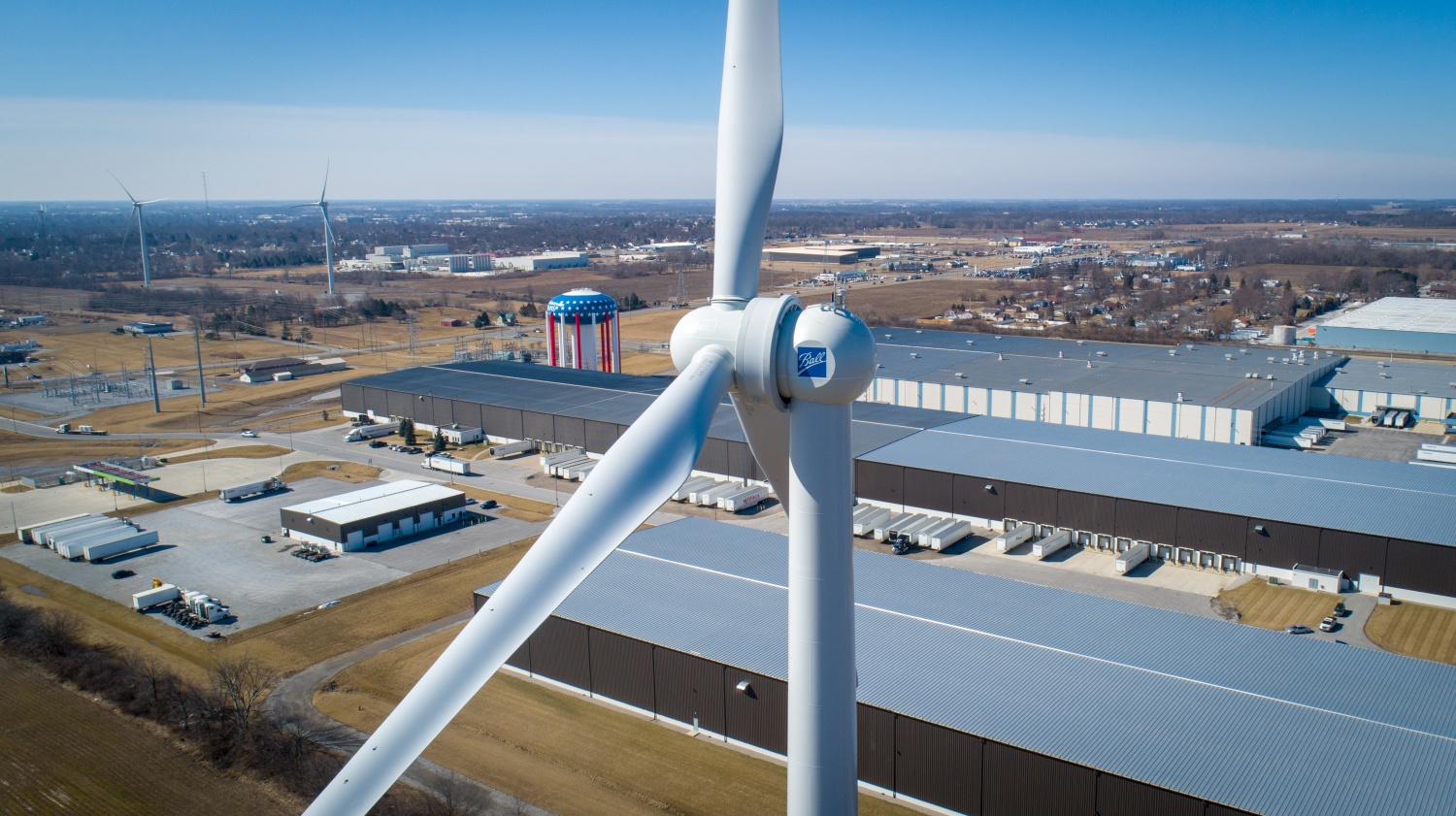

Here at One Energy, our wind turbine towers are erected in four separate sections: base, lower mid, upper mid, and top. The base is secured to the foundation using 120 anchor bolts and the next three sections are stacked and connected using a total of 358 bolts.
Today’s Wind View shows the top tower section being lowered into position above the upper mid by a crane. If you look closely, you can see two technicians waiting to guide and securely bolt the sections together. After the top is secured to the rest of the tower, we can continue the construction process.
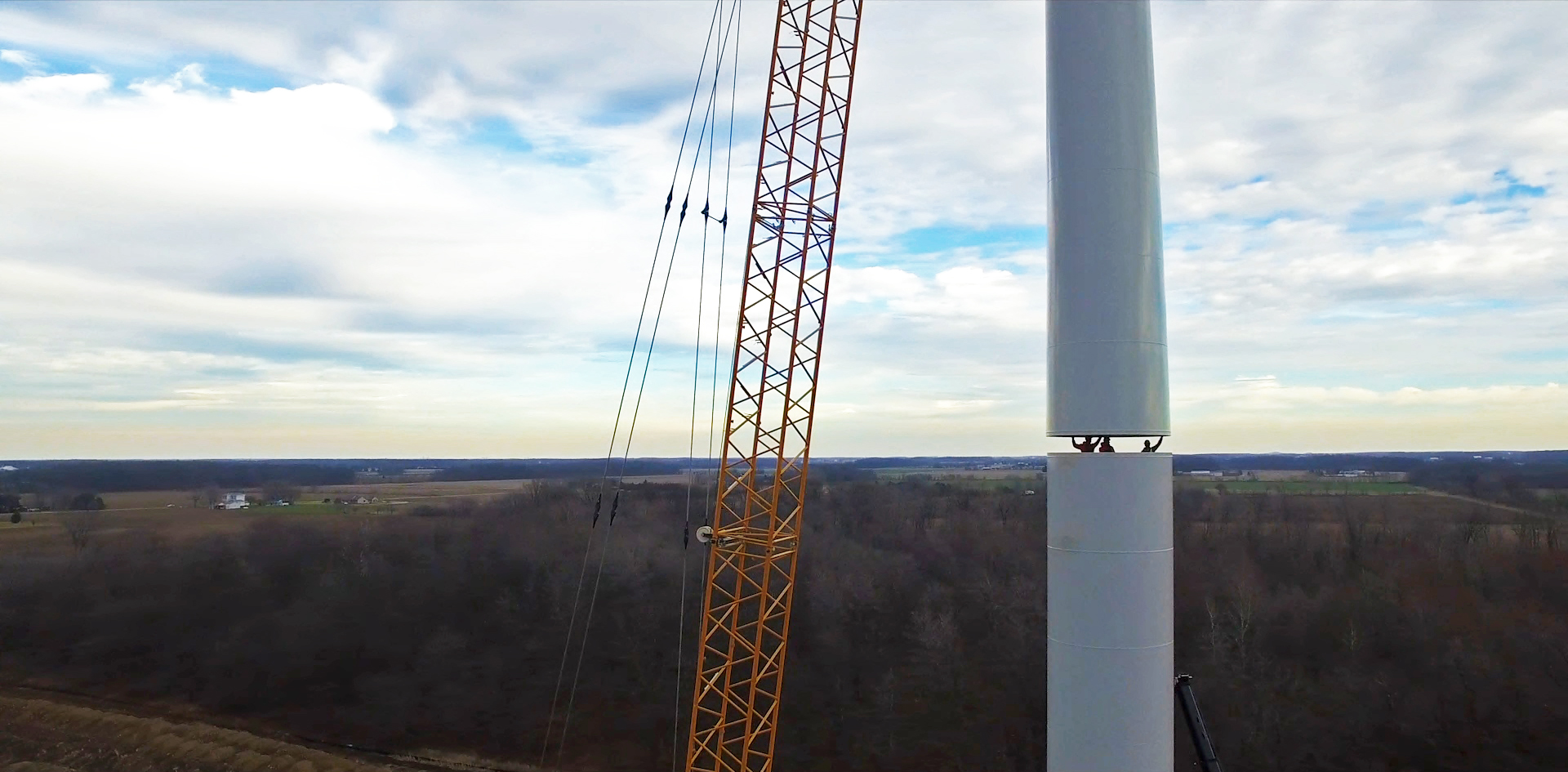

To apply for an entry-level engineering job at One Energy, we require applicants to answer a couple questions. One is a very technical question, the other is a more philosophical one. For the latter, we usually come up with an open-ended problem and ask them to provide out-of-the-box solutions that just might be crazy enough to work.
I thoroughly enjoy reading the answers that these applicants (typically current students or recent graduates) come up with. I’ve read that the static electricity from cat fur could be the next renewable energy, that potatoes could help power our electric grid, and that backpacks that store cow farts could help reduce global warming. These wild ideas come from the world of academia, where anything is possible.
Before I joined the private sector, I was in graduate school, where I witnessed plenty of unbridled minds as both a teacher and student myself. I watched students think obscurely and take time to imagine the ‘what ifs’ without fear of failure or the restrictions of reality. These ideas are so important, yet when I joined private industry, I learned very quickly that these ideas are largely ignored.
There has always been a disconnect between the world of academia and the world of private industry. Recently it has felt like that disconnect has been growing exponentially. It seems like the amazing research that is being done in our learning institutions is getting further and further from making its way into our homes. I’ve witnessed the impact this has had on the wind industry. The immovable wall that is “industry standard.” The inability to adapt quickly when new research comes out. The refusal to share data.
I believe the disconnect comes down to two things: academia’s failure to consider real world application, and industry’s failure to provide the context and information necessary to solve the most immediate problems.
Academia can go down rabbit holes. They tend to spend too much time trying to find the optimum solution instead of the solution that is needed and can be implemented. Academia needs to ask the simple questions of: “why?” and “how?” Why is the research needed? Why is this a problem that needs to be solved? And how will the solution be implemented? How will this be used in real life? They need to take their wild ideas and scale them to fit the real problem.
But if academia needs to be asking more questions, they need someone to respond. Private industry has not made itself accessible enough to the students and professors trying to solve problems. Far too often, research conducted on a campus has the ability to move entire industries forward, but is left collecting dust on a shelf. There is not enough collaboration between academia and industry, but there is also not enough collaboration within the industry itself.
It’s no secret that private industry does not like to share information, even if that information may benefit everyone. Fear of falling behind a competitor has sometimes led to the industry falling behind its potential. That fear has also had the side effect of widening the gap between the thinkers and the doers.
We, as an entire scientific community must be more open book. We need to share more often and more proactively. Academia needs to understand what the private industry needs, and the private industry needs to recognize the importance of academia’s ingenuity.
Open book in the scientific community starts with having conversations. Just last week I spent time talking to the National Renewable Energy Laboratory about how they could focus their research to best suit industry needs. At One Energy, I push my team to be overly available to research groups. We spend months helping students with their engineering capstone projects. We utilize the latest academic research to continuously make our methods better. We share data when most other industry players would not. We make our software open source so other brilliant minds can weigh in to make it better. We talk about transparency and we also live it. And transparency doesn’t just mean within our own company – it means across the entire wind energy community. If we’re going to solve the next big problem in the industry, we have to help the academics trying to help us. If we don’t, our industry will fail to meet its potential.
Jessica Grosso is the Head of Project Planning and Technology at One Energy.

Understanding wind speed is a crucial part of turbine siting – that is, determining where a turbine will be geographically placed for a wind energy project.
Wind speed on the ground or surface level is often different than the wind speed at “hub height” – the height at a given turbine model’s hub. (Remember that the hub is the component that holds together the turbine’s blades.)
In this week’s wind study, we’re exploring the relationship between wind speed and height, as well as the “Wind Profile Power Law,” using graphing and equations. 🔗Download the questions here and check back Friday for the answers!
Remember to share this educational series on Facebook and Twitter!
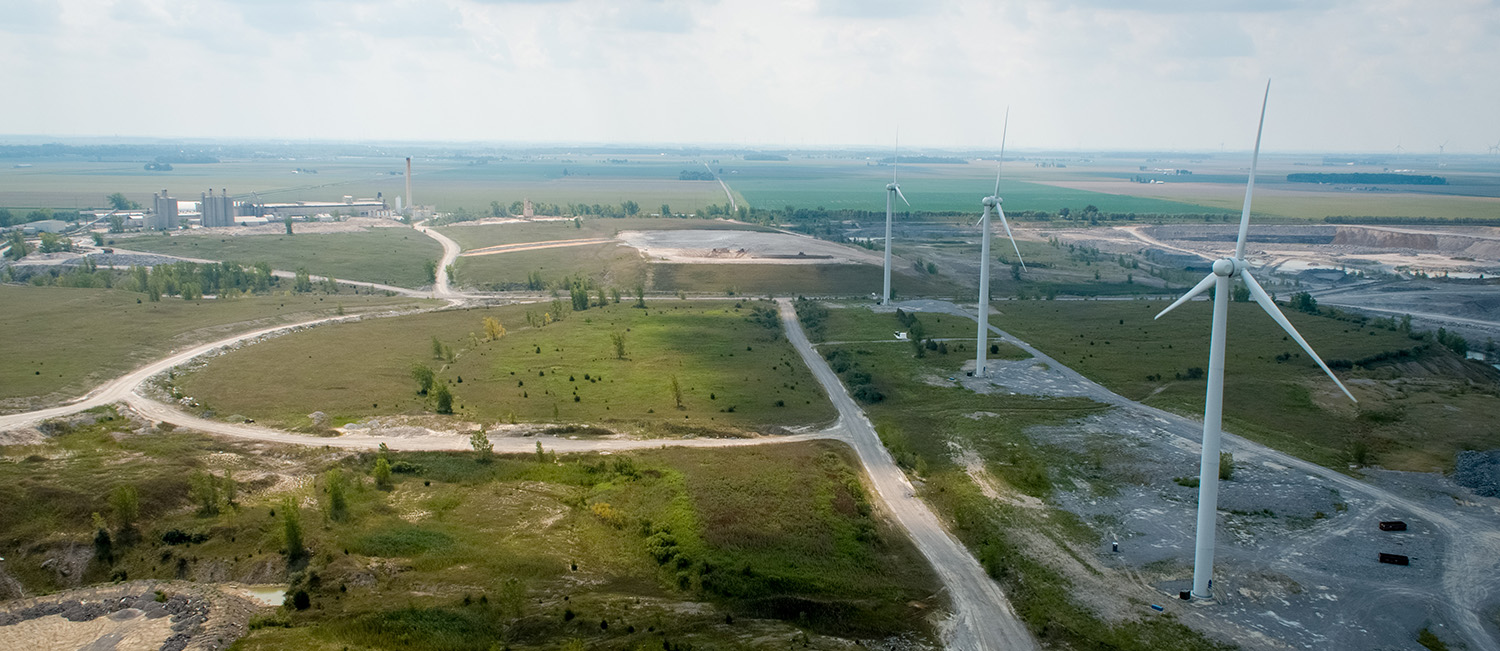

Opposites attract – at least when it comes to magnetic metals!
In today’s Science Short, Mitchel explains one of science’s mystifying concepts: magnets!
Watch to learn how tiny particles within some objects create a force of attraction – and why your refrigerator magnets can only hold up so many A+ tests at a time.
If you find that you’re attracted to educational videos, be sure to subscribe to our YouTube channel so you don’t miss any future Science Shorts! And share on Facebook and Instagram!

This week’s #WindStudy was all about electricity and magnetism – let’s see how you did!
🔗Download today’s homework answers here. (If you missed this week’s questions, you can find them here!)
If you’re wondering “what’s this got to do with wind energy?” – remember that some turbines (including those installed by One Energy) utilize permanent magnet direct drive generators – like the one being lifted by a crane in the photo below!
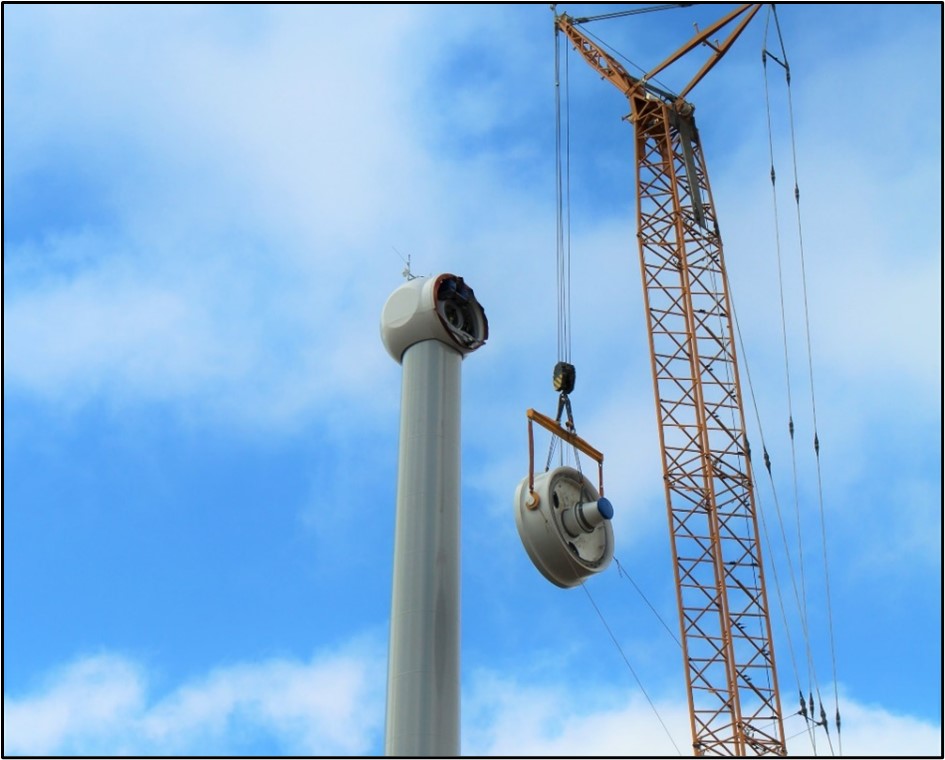
As always, you can find (and share!) this educational series on Facebook and Twitter!

My background is all things “regulatory.” I am a regulatory attorney, Head of Regulatory Affairs, former regulator, and former lawyer of regulators. I have spent A LOT of time working with (and unfortunately sometimes against) regulators. I have also spent a lot of time working with business leaders. The majority of whom, to put it bluntly, hate regulators. So, are regulators really the evil enemies that many businesses make them out to be?
I can honestly say that answer is YES. But at the same time, the answer is also, NO.
The truth is, regulators are before all else, human. They are people like you, like me, like the person who made you mad at Wal-Mart the other day because they cut you off and yelled at you, like the smartest and most reasonable colleague you have ever had. All of these types of people can be regulators.
So with that in mind, let’s dive more into what it means for a regulator to be a friend or a foe.
First, what does it look like to have a regulator that is a friend? Well, to put it plainly, regulators aren’t really meant to be your “friend.” They are meant to regulate you and scrutinize what you are doing. So the kind of “friendship” we are talking about here is different, and expectations need to be adjusted accordingly.
But there are a few qualities you can find in a great regulator to consider them a “friend.” A regulator is a “friend” when they are great at their job. When they are an expert in the area they regulate. When they love to “nerd out” about it. When you ask them a legitimate question and they can give you a knowledgeable, well-reasoned answer, or they promise to go find that answer and then do so. A regulator who is a “friend” is not on a power trip. Instead, they understand they have great power in their role, and they respect that power. Instead of using that power to bully, or to favor one industry over the other, they use that power to get to the bottom of an issue and help solve it in the fairest way possible. The majority of regulators I have met are “friends.”
Now let’s turn to what it looks like when a regulator is a “foe.” Regulators are foes when they have no clue about the area they regulate and they don’t even try to lean on others who do. A “foe” makes decisions based on their limited knowledge, no matter the collateral damage it causes. They have little or no legal basis for a decision they make and they don’t care. They know they have power and they throw it around haphazardly to impart their will on others or pursue an agenda. I have not met many of these regulators, but the few I have encountered made running a business a truly miserable and expensive experience, for no reason tied to fairness or the law.
But at the end of the day, though some regulators will act as your “friend” and some as a “foe,” they all regulate your business. And like every aspect of your business, you succeed when you recognize the realities of the world and react strategically to come out on top. So, instead of complaining about how regulators are your enemies, channel that energy instead towards getting your business the resources it needs to understand and comply with the regulatory environment in which you operate. Then, no matter if you run into a regulator who is a “friend” or “foe” you will be in a position to navigate every regulatory matter you encounter and come out of it far better off.
Katie Treadway is the Head of Regulatory Affairs at One Energy.

Back strains are an injury seen throughout the wind industry. These injuries are typically caused by activities related to offloading wind turbine tower sections from the trucks used to transport them.
A common industry practice is to use cribbing to support wind turbine tower sections while they rest on the ground. Often, this cribbing is made up of wooden railroad ties – heavy items that are moved manually by construction employees. It’s easy to understand how lugging 50 – 200 pounds of railroad ties could lead to injury.
At One Energy, we do things differently. Rather than hauling heavy railroad ties, we use “dunnage” that we make in-house out of easy-to-source materials. This dunnage is a simple solution that is also easy to transport, lift, and place beneath tower sections – eliminating the risk of back strains related to this wind energy construction activity.
Watch the video below to learn more about cribbing, dunnage, and how One Energy’s method prevents back strains!
Be sure to subscribe to our YouTube channel so you don’t miss a future minute.




